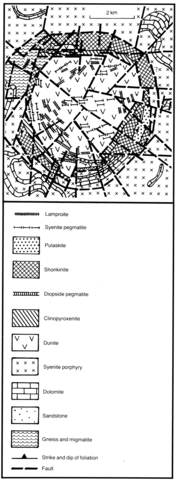stripes
The Inagli complex is situated in the western part of the central Aldan (Fig. 223) in the periphery of the Inagli magmatic dome. The complex has a ring form and an area of about 30 km2. The enclosing rocks include sandstones of upper Proterozoic age, lower Cambrian dolomites and dolomitized limestones and Precambrian crystalline rocks. The lower Cambrian sediments, which are generally subhorizontal, are slightly arched near the Inagli intrusion to form a dome-like structure 10-12 km in diameter. The Archaean basement is raised by about 200-300 m. Sills and laccoliths of trachydacite of lower Jurassic age are present in sedimentary rocks overlying platform rocks east of the massif. Small stocks of potassic alkaline granite and sills of syenite porphyry of lower Cretaceous age are also known in the area. Inagli is a complex, multi-phase pluton in which five structural units have been identified. (1) The core of the complex consists of dunites with rare intercalated layers of wehrlite. Drilling has indicated that the dunites persist to a depth of 900 m. The olivine of the dunites has the composition Fo92-93 with the unusual CaO content of up to 0.5-0.66% and a low nickel content. Pyroxenes from the ultramafic rocks are mostly diopside. (2) The periphery of the ultrabasic core has a complex structure and consists of metamorphosed phlogopitized dunite, phlogopite wehrlite and wehrlite. Olivine from this series of rocks has a lower CaO content. Blocks of dolomite, as well as a large number of sills of lamproite, similar in composition to the upper Jurassic lamproites of the Yakokut complex (locality 20), are found in the peripheral zone. (3) The inner intrusive ring zone consists of differentiated sub-vertical ring-dykes of olivine pyroxenite, missourite and shonkinite. These ring-dykes cut the dunites of the core. (4) The outer ring zone, which is 10-500 m wide, consists of shonkinite, melanocratic syenite, syenite and pulaskite. The shonkinite contains xenoliths of dunite, peridotite and limestone. (5) Ring zones of metasomatic rocks and pegmatites. The metasomatic rocks have several mineral associations including phlogopite with chrome-diopside and phlogopite + chrome-diopside + K-feldspar; the phlogopite has >14% Al2O3. The pegmatites consist mainly of feldspar and magnesioarfvedsonite in association with agpaitic accessory minerals and are concentrated mainly in zones of albitization and microclinization and include lamprophyllite, leucosphenite, batisite and innelite. Chemical compositions of rocks and minerals can be found in Orlova (1990) and Bogatikov et al. (1991).
BOGATIKOV, O.A., RYABCHIKOV, I.D., KONONOVA, V.A. et al. 1991. Lamproite. Nauka, Moscow. 320 pp.
GLAGOLEV, A.A. and KORCHAGIN, A.M. 1974. Alkaline-ultrabasic
massifs. Arbarastakh and Inagli. Nauka, Moscow. 176 pp.
KORCHAGIN, A.M. 1966. A vermiculite-phlogopite deposit at Inagli. Izvestiya Akademii Nauk SSSR, Seriya Geologiya, 8: 86-97.
KRAVCHENKO, S.M., KAPUSTIN, Yu.L., KATAEVA, Z.T. and BYKOVA, A.V. 1982. Agpaitic mineralization of the Mesozoic metasomatic rocks of potassic alkaline complexes of the Central Aldan. Doklady Akademii Nauk SSSR, 263: 435-9.
ORLOVA, M.P. 1990. Mesozoic stage of magmatism. In G.V. Polyakov and V.V. Kepezinskas (eds) Potassic alkaline magmatism of the Baikal-Stanovoy rift system. 65-123. Nauka, Siberian Division of the USSR Academy of Sciences, Novosibirsk.
ORLOVA, M.P., KURANOVA, V.N., SOSEDKO, T.A., CHEREPANOV, V.A. and SHCHADENKOV, E.M. 1986b. Mineralogy and genesis of chrome-diopsides from the Inagli massif (Aldan). In J. Mincava-Stefanova (ed) Morphology and phase equilibria of minerals. Proceedings of the 13th General Meeting of the International Mineralogical Association (IMA) in 1982. 449-60. Bulgarian Academy of Sciences, Sofia.
SVESHNIKOVA, E.V. and EREMEYEV, N.V. 1982. Ore-bearing polyformation magmatic complexes of the central part of the Aldan shield. In. A.V. Sidorenko (ed) Ore-bearing structures of the Precambrian. 105-16. Nauka, Moscow.

